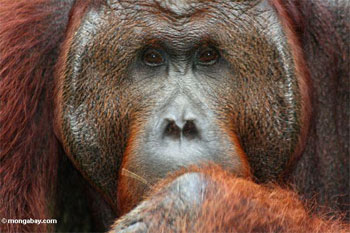Tropical Asia needs to act to save biodiversity, say scientists
Tropical Asia needs to act to save biodiversity, say scientists
mongabay.com
July 22, 2006
A group of scientists urged governments of tropical Asia to take steps to stem biodiversity loss across the region.
At the annual meeting for the Association for Tropical Biology and Conservation, hosted at the Tropical Botanical Garden (XTBG) of the Chinese Academy of Sciences in the Yunnan province of China, scientists said that population growth and booming economic expansion are fueling illegal logging, wildlife poaching, and habitat destruction. The scientists noted that populations of elephants, rhinoceroses, tigers, sun bears, orangutans, and other species unique to tropical Asia have fallen significantly in recent years as a result of these activities.
The scientists urged regional governments to support and protect existing parks while setting aside more land for conservation. They said China — the third most biodiverse country on earth with more 35,000 species of amphibians, birds, mammals, reptiles, and vascular plants — could play a key role in saefgaurding biodiversity across the Asia-Pacific Region.
Below is the Kunming Declaration which sets forth objectives for conservation and strategic research in tropical Asia.
THE KUNMING DECLARATION
(21 JULY 2006)
THE CRITICAL NEED FOR FOREST CONSERVATION AND STRATEGIC RESEARCH IN TROPICAL ASIA
WHEREAS, the biological diversity of tropical forests in Asia is among the very richest and most spectacular on the planet, and likely accounts for at least a quarter of all species on Earth; and

Orangutan in Kalimantan, photo by Rhett A. Butler. More pictures from Kalimantan In search of Bigfoot, scientists may uncover unknown biodiversity in Malaysia Malaysian scientists are scouring the rainforests of Johor state in search of the legendary ape-man Bigfoot, supposedly sighted late last year. But they are more likely to encounter some less fantastic but unique creatures that dwell in these still unexplored ecosystems. Saving Orangutans in Borneo. I’m in Tanjung Puting National Park in southern Kalimantan on the island of Borneo. At 400,000 hectares (988,000 acres) Tanjung Puting is the largest protected expanse of coastal tropical heath and peat swamp forest in southeast Asia. It’s also one of the biggest remaining habitats for the critically endangered orangutan, the population of which has been great diminished in recent years due to habitat destruction and poaching. Orangutans have become the focus of a much wider effort to save Borneo’s natural environment.
|
WHEREAS, Asia has the highest deforestation rate of any major tropical region in the world, and is also being massively altered by rampant industrial logging, plantation expansion, overhunting, the illegal trade in wildlife and wildlife products, pollution and degradation of freshwater and coastal marine ecosystems, rapid human population growth, and other threats; and
WHEREAS, many species in tropical Asia have naturally restricted geographic ranges and small population sizes, rendering them inherently vulnerable to habitat destruction and degradation; and
WHEREAS, the geographic ranges and population sizes of large forest wildlife, such as elephants, rhinoceroses, tigers, sun bears, and orangutans, have collapsed dramatically in the region, to the degree that very few forests today contain the full complement of their original megafauna; and
WHEREAS, many important ecosystems in tropical Asia are seriously underrepresented within national parks and protected areas, leaving them highly vulnerable to future loss and degradation; and
WHEREAS, spectacular economic growth in Asia, particularly in China and India, is greatly escalating demands for timber, bush meat, wildlife products, agricultural land, and infrastructure expansion throughout the region, and often leads to the destructive or unsustainable use of natural resources; and
WHEREAS, rapid economic growth and the impressive development of scientific expertise in tropical Asia are creating important new opportunities for targeted research and conservation initiatives;
THEREFORE, BE IT RESOLVED that the Association for Tropical Biology and Conservation:
- URGES the nations of tropical Asia to expand the number and size of protected areas within their borders, especially for forest types and eco-regions that are poorly protected in existing reserves, and for the increasingly rare areas that still retain their highly vulnerable megafauna; and
- IMPLORES the nations of tropical Asia to support existing protected areas against illegal hunting, logging, encroachment, and other degrading activities, providing the political will and resources needed to ensure their long-term protection, especially for surviving megafauna; and
- STRONGLY SUGGESTS that reserves be linked wherever possible into regional networks and cross-national corridors, to increase their size and effectiveness for area-sensitive wildlife, and to reduce their vulnerability to many external threats; and
- RECOMMENDS that financial support be substantially increased for scientific strategies to (a) restore degraded and secondary forests, (b) identify key regions of high biological and conservation significance, (c) enhance and maintain functional connectivity for wildlife among existing and planned reserves; (d) develop multi-national research, collaboration, and capacity-building; and (e) devise sustainable strategies for natural-resource development; and
- STRONGLY SUGGESTS that policy makers in tropical Asia engage in an active and ongoing dialogue with informed scientists, in order to better understand the critical challenges facing the region and its vital natural resources; and
- URGES the People’s Republic of China, by virtue of its growing economic power, considerable scientific expertise, and growing demands on natural resources in the Asia-Pacific Region, to take a leading role in promoting, funding, and developing more sustainable development strategies and conservation initiatives in tropical Asia.
The ATBC
The Association for Tropical Biology and Conservation (www.atbio.org) is the world’s largest scientific organization devoted to the study, conservation, and wise use of tropical ecosystems. Founded in 1963, the ATBC has over 1200 members from more than 70 nations worldwide.
The most recent annual meeting of the ATBC was held in Kunming, China, from 18-21 July 2006, hosted by the Xishuangbanna Tropical Botanical Garden and the Chinese Academy of Sciences.














